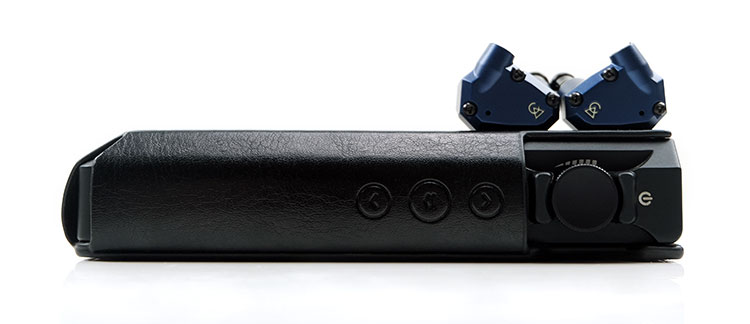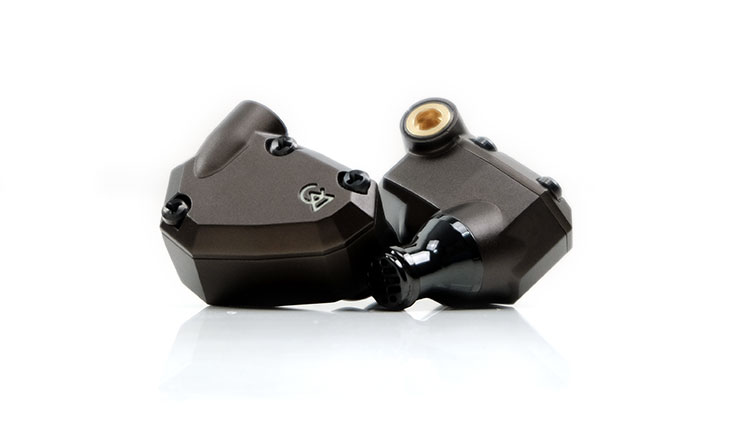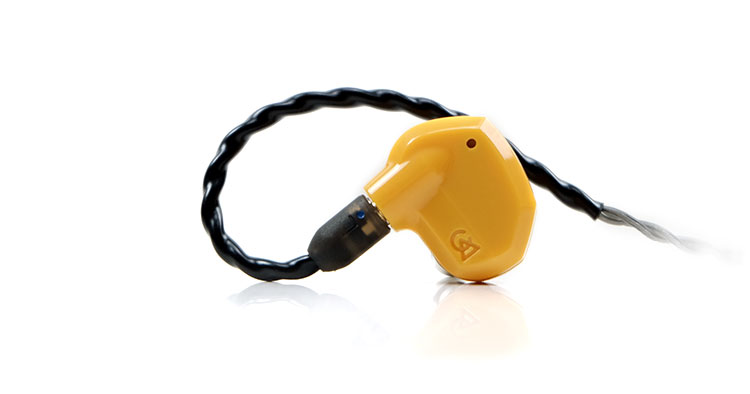Synergy
Efficiency
The Mammoth is rated at 8.1Ω with an SPL of 18.16 mVrms to achieve 94dB SPL @1kHz using CA’s new benchmark measurement system.
It is a little less sensitive than the likes of the Andromeda 2020 and the newer Holocene but it is roughly in line with most of CA’s dynamic driver configurations such as the Honeydew and the older Polaris 2.
What that means is an IEM that’s fairly easy to drive on most sources with very good performance on higher noise floors in terms of background hiss. All our test DAPs ran very quietly including the iBasso DX160 and the Cayin N6ii/R01 pairings.
Pairings
I found the best pairings with the Mammoth were those sources that did very well in teasing out the energy and low-end presence of that 10mm dynamic driver but at the same time didn’t diminish or wall in the mids and treble.
If you are going to buy a ‘musical’ IEM you need a source that will maximize that. Of the 4 DAPs tested, the two Cayin models, the N6ii/R01 on the high-end and the N3Pro on the more affordable side created the ideal synergy for me on that premise.
The R01 motherboard has some seriously excellent low-end rumble and does very well with the Mammoth’s sub-bass presence. It actually has one of the cleaner mids and trebles performances despite being a very smooth analog tone so it does give a nice lift to the Mammoth mids and treble.
The N3Pro’s solid-state timbre is less impressive and actually felt like it limited the dynamic range of the Mammoth in comparison to the more open-sounding Ultralinear tube timbre mode. The weight of the bass falls off a little but the mids and treble of the Mammoth come to the fore quite nicely.
Neutral DAPs such as the DX160 and even the high-end LPGT just sounded a little sterile for me when paired with the Mammoth. Perhaps going too neutral robs the performance of a bit of fun.
You can remedy it with some PMEQ and both DAPs have an excellent EQ system to allow you to do that. I actually found a bit of a bump around 8-10k gave both pairings some additional contrast and welcome vibrancy.
Select Comparisons
Campfire Audio Polaris 2
$499 (Currently sold out)
Technical
The Polaris was first launched in 2017 and went through 2 iterations and is now just recently discontinued. The Mammoth has taken up the mantle but this is not a like-for-like replacement despite both having a bass-heavy signature.
While both are hybrid driver monitors, the Polaris 2 used a smaller 9.2mm dynamic driver in tandem with CA’s Polarity Tuned Chamber technology and just a single BA driver for the highs in combination with T.E.A.C. tubeless technology.
Quite how the Polaris chamber differs from the newer acoustically optimized 3D printed interior chamber and rear port design is unclear but given the Mammoth uses a larger 10mm bio-cellulose dynamic driver purely for the lows this switch might be driven by size and uniformity.
There is also no T.E.A.C tubeless tech used inside the Mammoth. Instead, we have 2 custom BA drivers to cover the mids and highs with the dynamic driver focusing more on the lows.
Sensitivity ratings are different both in terms of actual and benchmarking with the Mammoth rated at 8.1Ω and the Polaris 2 a little higher at 17Ω. The 18.16 mVrms SPL rating for the Mammoth is measured using CA’s new 94dB @1kHz benchmark rating whereas the Polaris 2 is rated at 105dB using the older standard SPL/mW Sensitivity @1k.
In our real-world testing, the Mammoth proved to be a little more sensitive compared to the Polaris 2 using the Lotoo PAW Gold Touch in SE low-gain mode. Both handle amp stage high noise floors quite well with barely any hiss from the likes of the FiiO M15 and the Cayin N3Pro using their respective low gain SE outputs.
Design
Very similar designs with both monitors using the classic 2nd generation aluminum and anodized edged shells with the black tri-lobe screws and bass venting port on their respective faceplates.
The key difference is the color scheme with the Mammoth using a darker ‘Frozen Tundra’ anodized finish and the Polaris 2 sporting a lighter Cerulean blue theme. A more nuanced change is the white finish of the etched logo on the Mammoth faceplate that stands out a bit more compared to the all-blue version on the Polaris.
Comfort and isolation are unchanged also with your choice of tips having the final say. I prefer the Final E tips with each for both better comfort and audio performance levels.
Connect the cables, however, and you do get that glow-in-the-dark effect on the connectors for the Mammoth that the Polaris 2 does not have. Aside from the glowing effects, both monitor’s cables are the same lightweight Smoky Litz SPC 4-wire internals with springy soft memory wraps, adjustable aluminum chin cinch, and 3.5mm TRS/MMCX terminations.
The performance from both cables is exactly the same meaning low microphonics and relatively low memory retention also.
Performance
The Polaris 2 has a stronger v-shape with plenty of bass rumble, a dipped mids with minor nudges in the upper-mids and an emphasized 6-8k treble presence. There are some big presence touchpoints on the very low-end countered by a peak at the very top-end.
The Mammoth is the more balanced for the mids but also the darker of the two. Yes, it does have a fairly emphasized bass response but it is not as L-shaped as the 20Hz to 1k curve of the Polaris 2. It has more of an elevated but linear 20Hz to 100Hz elevation that drops earlier around 200-300Hz with a low point around 600Hz-1K.
The Polaris 2 tends to hold onto its bloom a lot longer cutting deeper and more sharply in the lower-mids leaving a lot less space for midrange instruments and vocals to breathe compared to the Mammoth. That additional BA for the mids delivers better detail on the Mammoth from 1-4k compared to the dipped thinner sound from the Polaris 2.
Granted, the treble is more muted on the Mammoth and not as sparkling as the Polaris 2. You do get a richer but more rounded vocal and instrumental timbre but they do have more presence and suffer from less bleed compared to the Polaris 2.
Put it this way, the Polaris 2 delivers that classic V-Shaped sound that is 100% built for stripped-down synth-wave, modern R’n’B mixing with clean higher-pitched dominant female vocals. It has little room for anything else more complex.
The Mammoth still has the chops to deliver the slam for the same genres but its better midrange presence and tapered bass bloom make it more amenable for male vocals and power metal that I can’t really pair the Polaris 2 with.
Campfire Audio Holocene
$649
Technical
The Holocene was launched at the same time as the Mammoth this year and it’s also a triple driver IEM but it’s an entirely different proposition with no natural predecessor.
Inside, this is a triple BA driver configuration with an even split of one each for the lows, mids, and highs compared to the Mammoths hybrid single 10mm dynamic for the lows and a BA each for the mids and highs.
Both monitors, however, share the same 3D printed acoustically optimized interior chamber though there is no rear venting in the same way as required for the dynamic driver inside the Mammoth. That means no port on the faceplate for the Holocene.
In terms of sensitivity, the Holocene is the easier of the two to drive at just 5.4Ω and 6.99 mVrms, (94dB SPL @1kHz) compared to the Mammoth which is rated at 8.1Ω and 18.16 mVrms.
Design
There isn’t a lick of difference between these two monitors save for the color scheme and the venting port on the faceplate of the Mammoth for the dynamic driver to breathe.
That means both using machined aluminum bodies with edged curving, beryllium/copper MMCX connectors, and stainless-steel spouts with black PVD finishing.
The color scheme for the Holocene is an ‘Umber’ anodized finish as opposed to the ‘Frozen Tundra’ of the mammoth. Basically, brown vs blue and both finished with the new etched white glow-in-the-dark logo on the faceplate.
Both the Mammoth and Holocene cables also get the glow-in-the-dark treatment with matching Smoky Glow Litz wire as well as the glow-treated carry case zipper and CA logo on the front. All that’s aesthetically changed is the color scheme.
Performance
It is early days yet with the Holocene and we will have a full review in due course but this one is shaping up to be CA’s ‘sleeper mid-fi hit’ in terms of getting the balance between technical and tone just right.
With an all-BA configuration, the timbre is a bit more coherent compared to the dynamic/BA contrast from the Mammoth. I would describe this as ‘neutral to natural’ with a gentle but broad lift from the sub-bass peaking around 100Hz, then a smooth drop to around 1k.
Lower-mids do not sound as scooped as the Mammoth but they do not need to be as the bass weight and warmth from the low-end BA driver is very tight, controlled, and articulate. That allows midrange instruments to come to the fore with plenty of space to breathe.
On the flip side, it’s nowhere near as heavy or planted as the Mammoth’s dynamic driver. The Mammoth will give you much more authority and a stronger bass fundamental and in doing so creates a deeper soundstage.
Vocals are actually imaging a bit further forward on the Mammoth compared to the more neutral placement of the Holocene midrange. However, the Holocene has a much better upper treble extension which creates a bit more shimmer and sparkle on the mids instrumental and vocal timbre.
That can often bring out a perception of improved clarity and space and indeed this is the case here. The Mammoth has a rounded darker timbral tone and better note body but the Holocene has that ethereal airy quality consistent with a dipped lower treble and enhanced upper treble presence.
Campfire Audio Honeydew
$249
Technical
The Honeydew is one of Campfire’s two entry-level IEMs launched in 2021 and this one, like the Mammoth, has a fairly strong slant to a bass sound signature.
Unlike the hybrid triple driver Mammoth, the Honeydew is a single dynamic driver implementation with no additional BA. That means a single 10mm LCP diaphragm driver covering the entire range whereas the 10mm bio-cellulose DD inside the Mammoth is focused purely on the lows.
Both monitors do have some shared characteristics, namely, a 3D printed internal acoustic chamber and airflow system with bass venting via a faceplate hole and beryllium/MMCX connectors.
In terms of SPL, the Honeydew has similar driving requirements to hit 94dB at 17.68mVrms compared to 18.16 mVrms for the Mammoth. The Honeydew driver does need a bit more voltage at 17.44Ω compared to 8.1Ω but the gap is not huge with both being fairly easy to drive off most decent sources.
Design
The Honeydew ‘mellow yellow’ aesthetic is composed of cheaper injection-molded ABS compared to the more durable and bigger machined aluminum body of the Mammoth. However, I think the smaller lighter form factor and smoother curving of the Honeydew make it the comfier of the two monitors in the ear.
Both IEMs share the same stainless-steel spout concept. However, the Mammoth version has the black PVD finish and is a bit thicker whereas the Honeydew version has the classic silver or chrome finish. Isolation is very similar also with that venting port on the plate and similar supplied tips.
The Honeydew also uses the Smoky Litz 4-wire SPC with a dark smoky jacket, right-angle 3.5mm TRS jack, and MMCX connectors. However, it lacks the glow-in-the-dark special effects from the connectors and jack barrels. The same can be said also for the Honeydew’s Vine Green carry case, sans ‘lighting effects’.
Performance
No doubt the Mammoth is an upgrade on the Honeydew in terms of resolution and FR balance. The additional dual BA does bring in more contrast in the Mammoth’s timbre that the Honeydew avoids being a single DD. However, that allows CA a bit more freedom to shape the mids and treble for better clarity and presence.
Both hit hard on the low-end, more so the Honeydew for my money. However, the Mammoth bass is not as overblown sounding more controlled and punchier. This allows for more space for those two BA to breathe and brings some additional complexity and detail to the overall performance. Vocals and percussion also deliver superior presence with a more accurate tonal balance.
In comparison, the Honeydew sounds a lot warmer, softer in the attack, and comparatively veiled in the mids for anything that has a stronger midrange arrangement and vocal presence. Neither has huge treble or bags of headroom but the Mammoth’s twin BA does create a cleaner more articulate treble performance.
The Honeydew does respond quite well to a broad PMEQ 1k-10k push with peaking around 5k, (Q Factor 0.7), to tease out some improved treble presence and sparkle. You can hit around 10dB gain without any signs of distortion. The BA of the Mammoth are not quite as flexible for extreme EQ but 4-5dB peaking around 8-10k can give it a welcome lift also.
Overall, the Honeydew is really at home with space, be it sparse synthwave or modern R’n’B it will hit hard with simpler mixes. Whereas the more balanced tuning of the Mammoth will be just fine with those genres but, like the Polaris 2 comparison, it is a much better pairing for more mids-centric rock that needs a strong fundamental also.
Our Verdict
In many ways, I find the tuning and technical performance of the Mammoth to be a more mature and flexible offering compared to the niche ultra-bass head tuning of the previous Polaris 2. Both work very well indeed for synthwave and EDM lovers but that stronger midrange performance of the Mammoth lends itself better to classic rock and metal vocals.
Also, for Honeydew users looking for an upgrade path then the Mammoth is the most logical next step in the Campfire Audio IEM ecosystem. It is more resolving, offers a better balance but still delivers some seriously powerful lows.
Overall, the Mammoth is still CA’s candlelight vigil on the mid-fi tier for a balls-out bass-heavy smooth sound signature. It is built for fun, tuned for enjoyment, and like the Satsuma/Honeydew launch before it, provides a very different sound signature to its mid-fi sibling, the Holocene.
Campfire Audio Mammoth Specifications
- 5Hz–20 kHz Frequency Response
- 94 dB SPL @ 1kHz: 18.16 mVrms
- 8.1 Ohms @ 1kHz Impedance






